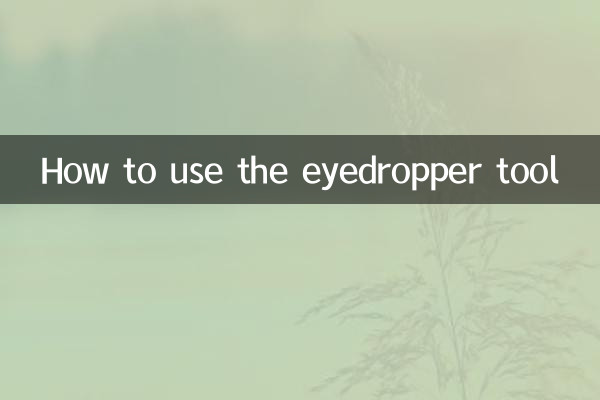How to use the eyedropper tool
In the field of design and image processing, the eyedropper tool is a very practical function, which can help users quickly obtain color values and improve work efficiency. Whether it is Photoshop, Illustrator or other design software, the eyedropper tool plays an important role. This article will introduce in detail how to use the eyedropper tool, and provide you with a comprehensive guide based on hot topics and hot content on the Internet in the past 10 days.
1. Basic functions of the straw tool

The eyedropper tool is primarily used to suck color values from an image or design and apply them to other elements. Here are the main features of the eyedropper tool:
| Function | Description |
|---|---|
| color absorption | Extract color values at specific locations from an image |
| Color application | Apply picked colors to other graphics or text |
| color sampling | Support multi-point sampling to obtain average color value |
2. How to use the eyedropper tool in different software
The operation of the eyedropper tool in different design software is slightly different. The following are how to use it in several common software:
| Software | How to operate |
|---|---|
| Photoshop | 1. Select the eyedropper tool (shortcut key I) 2. Click on the target color in the image 3. The absorbed color will be displayed in the foreground color |
| Illustrator | 1. Select the eyedropper tool (shortcut key I) 2. Click on the target object to absorb the color 3. Click on other objects to apply color |
| CorelDRAW | 1. Select the Eyedropper tool 2. Click the target color 3. Use the paint bucket tool to apply color |
3. The combination of the hot topics on the Internet in the past 10 days and the straw tool
Recently, discussions related to the eyedropper tool have mainly focused on the following hot topics:
| hot topics | Related content |
|---|---|
| Improved design efficiency | How to Use the Eyedropper Tool to Quickly Match Brand Colors |
| UI/UX design | Application skills of the eyedropper tool in mobile design |
| color psychology | Analyze the color combinations of popular designs with the eyedropper tool |
4. Advanced tips for using straw tools
In addition to its basic functions, the eyedropper tool also has some advanced usage tips that can help you complete your design work more efficiently:
1.multi-point sampling: In Photoshop, hold down the Shift key to add multiple sampling points and obtain the average color value.
2.Color picking across software: Use third-party tools (such as ColorSnapper) to quickly select colors between different software.
3.Color history: Some software supports color history recording function to facilitate reuse of commonly used colors.
5. Application of straw tools in actual cases
The following is a practical example showing the specific application of the eyedropper tool in design:
| Case | steps |
|---|---|
| Brand poster design | 1. Use the eyedropper tool to absorb the main color of the brand logo 2. Apply color to poster background and text 3. Ensure overall design color consistency |
6. Frequently Asked Questions
1.Why is the color picked up by the eyedropper tool inaccurate?
It may be due to low image resolution or screen chromatic aberration, it is recommended to check the image quality and monitor calibration.
2.Can the eyedropper tool pick up gradient colors?
Yes, but you'll need to manually select specific points in the gradient to sample.
3.How to synchronize absorbed colors between different devices?
Color coding (such as HEX or RGB values) can be used for recording and synchronization.
Summary
The eyedropper tool is a powerful assistant for designers, and mastering its use can significantly improve work efficiency. Through the introduction of this article, you should have a deeper understanding of the functions, usage techniques and practical applications of the eyedropper tool. Combined with the recent hot topics on the Internet, I hope you can make better use of this tool in design and create better works.

check the details

check the details